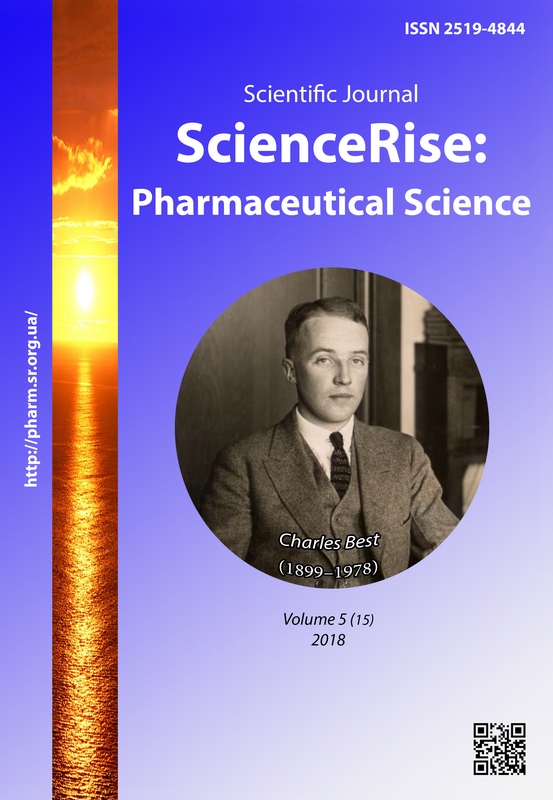Technology of obtaining and investigation of chemical composition of dense extract of hawthorn fruits
DOI:
https://doi.org/10.15587/2519-4852.2018.146473Keywords:
hawthorn, fruits, dense extracts, chemical composition, technology, flavonoids, hydroxycinnamic acids, amino acidsAbstract
In the pharmaceutical market of Ukraine, liquid dosage forms of hawthorn are present and used in complex treatment of cardiovascular diseases. Ukrainian flora has more than 30 species of hawthorns, among which there are unofficial species of wild and cultural species with sufficient raw material base.
Aim. To develop a technology for obtaining of dense fruit extracts of unofficial hawthorn species and to determine the chemical composition of the obtained extracts.
Methods. For determination of BAS dense of hawthorn fruit extracts was used spectrophotometric method and the method of high performance liquid chromatography (HPLC).
Results. The technological scheme of obtaining dense extracts of hawthorn fruit was developed. The content of amino acids, flavonoids and hydroxycinnamic acids was established in густих extracts of fruits C. prunifolia Sarg., С. pseudokyrtostilla Klok. and С. leiomonogyna Klok.. The content of flavonoids ranged from 4.27 % ±0.01 to 10.94 % ± 0.10; hydroxycinnamic acids - from 1.45 % ± 0.02 to 2.56 % ± 0.10. By used the HPLC method in all extracts was detected rutin, chlorogenic and ferulic acids. In dense extract of C. prunifolia Sarg. fruits apigenin-7-O-rhamnoside was identified; С. pseudokyrtostilla Klok. and С. leiomonogyna Klok. - apigenin-7-O-glycoside, apigenin, luteolin; С. leiomonogyna Klok.- luteolin-7-O-diglycoside and quercetin.
Conclusions. Dense fruit extracts of C. prunifolia Sarg., С. pseudokyrtostilla Klok. and С. leiomonogyna Klok. were obtained. For the first time, the HPLC method in extracts has determined the content of flavonoids and hydroxycinnamic acids. A comparative study of the amino acid composition of the extracts was carried out
References
- Goncharov, N. F., Sidora, N. V., Kovaleva, A. M., Komissarenko, A. N. (2008). Fenol'nye soedineniya severoamerikanskikh vidov roda boyaryshnik. Rossiyskiy mediko-biologicheskiy vestnik imeni akademika Pavlova, 3, 150–154.
- Phipps, J. B., Robertson, K. R., Rohrer, J. R., Smith, P. G. (1991). Origins and Evolution of Subfam. Maloideae (Rosaceae). Systematic Botany, 16 (2), 303–332. doi: http://doi.org/10.2307/2419283
- Talent, N., Dickinson, T. A. (2005). Polyploidy in Crataegus and Mespilus (Rosaceae, Maloideae): evolutionary inferences from flow cytometry of nuclear DNA amounts. Canadian Journal of Botany, 83 (10), 1268–1304. doi: http://doi.org/10.1139/b05-088
- Hamahameen, B. A., Jamal, B. (2013). Determination of Flavonoids in the Leaves of Hawthorn (Crataegus Azarolus ) of Iraqi Kurdistan Region by HPLCAnalysis. International Journal of Bioscience, Biochemistry and Bioinformatics, 3 (1), 67–70. doi: http://doi.org/10.7763/ijbbb.2013.v3.166
- Skhiri, F. H., Bahri-Sahl, R., Ammar, S., Fredj, R. B., Saguem, S., Grec, S., Trotin, F. (2009). Polyphenol Contents and Antioxidant Activities of Extracts from Flowers of Two Crataegus azarolus L. Varieties. Pakistan Journal of Biological Sciences, 12 (9), 660–668. doi: http://doi.org/10.3923/pjbs.2009.660.668
- Chen, J. A., Song, S., He, J., Xu, S. (2008). Study of the chemical constituents of the leaves of Crataegus pinnatifida. Asian Journal of Traditional Medicines, 3, 80–83.
- Kumar, D., Arya, V., Bhat, Z. A., Khan, N. A., Prasad, D. N. (2012). The genus Crataegus: chemical and pharmacological perspectives. Revista Brasileira de Farmacognosia, 22 (5), 1187–1200. doi: http://doi.org/10.1590/s0102-695x2012005000094
- Schussler, M., Holzl, J., Fricke, U. (1995). Myocardial effects of flavonoids from crataegus species. Arzneimittel Forschung, 45 (7), 842.
- Schüssler, M., Hölzl, J., Rump, A. F. E., Fricke, U. (1995). Functional and antiischaemic effects of monoacetyl-vitexinrhamnoside in different in vitro models. General Pharmacology: The Vascular System, 26 (7), 1565–1570. doi: http://doi.org/10.1016/0306-3623(95)00051-8
- Mraihi, F., Hidalgo, M., de Pascual-Teresa, S., Trabelsi-Ayadi, M., Chérif, J.-K. (2015). Wild grown red and yellow hawthorn fruits from Tunisia as source of antioxidants. Arabian Journal of Chemistry, 8 (4), 570–578. doi: http://doi.org/10.1016/j.arabjc.2014.11.045
- Furey, A., Tassell, M., Kingston, R., Gilroy, D., Lehane, M. (2010). Hawthorn (Crataegus spp.) in the treatment of cardiovascular disease. Pharmacognosy Reviews, 4 (7), 32–41. doi: http://doi.org/10.4103/0973-7847.65324
- Furey, A., Tassell, M. (2008). Towards a systematic scientific approach in the assessment of efficacy of an herbal preparation: Hawthorn (Crataegusspp.). European Journal of Heart Failure, 10 (12), 1153–1157. doi: http://doi.org/10.1016/j.ejheart.2008.10.003
- Hwang, H. S., Boluyt, M. O., Converso, K., Russell, M. W., Bleske, B. E. (2009). Effects of Hawthorn on the Progression of Heart Failure in a Rat Model of Aortic Constriction. Pharmacotherapy, 29 (6), 639–648. doi: http://doi.org/10.1592/phco.29.6.639
- Georg Belz, G., Loew, D. (2003). Dose-response related efficacy in orthostatic hypotension of a fixed combination of D-camphor and an extract from fresh Crataegus Berries and the contribution of the single components. Phytomedicine, 10, 61–67. doi: http://doi.org/10.1078/1433-187x-00303
- Derzhavna Farmakopeia Ukrainy (2009). DP «Ukrainskyi naukovyi farmakopeinyi tsentr yakosti likarskykh zasobiv». Kharkiv: RIREH, 280.
- Derzhavna Farmakopeia Ukrainy (2015). DP «Ukrainskyi naukovyi farmakopeinyi tsentr yakosti likarskykh zasobiv». Vol. 1. Kharkiv: RIREH, 1128.
- Kurkina, A. V. (2011). Metodika opredeleniya kolichestvennogo soderzhaniya summy flavonoidov v trave repeshka aptechnogo. Khimiko-farmacevticheskiy zhurnal, 45 (1), 31–34.
- Lenchyk, L. V. (2016). Determination of phenolic compounds in prunus domestica leaves extract. Scripta Scientifica Pharmaceutica, 2 (2), 31–35. doi: http://doi.org/10.14748/ssp.v2i2.1302
- Lenchyk, L., Shapoval, O., Kyslychenko, V. (2016). Phytochemical study and determination of pharmacological activities of cherry shoots dry extract. ScienceRise: Pharmaceutical Science, 1 (1), 40–45. doi: http://doi.org/10.15587/2519-4852.2016.72746
- Mraihi, F., Fadhill, H., Trabelsi-Ayadi, M. (2015). Chemical characterization by HPLC-DAD-ESI/MS of flavonoids from hawthorn fruits and their inhibition of homan tumor growth. Journal of New Sciences, Agriculture and Biotechnology, 3, 840–846.
- Lenchyk, L. V., Upyr, D. V., Ovezgeldiyev, D. (2016). Phytochemical investigation of bird cherry fruits. Der Pharmacia Lettre, 8 (6), 73–76.
- Jámbor, A., Molnár-Perl, I. (2009). Amino acid analysis by high-performance liquid chromatography after derivatization with 9-fluorenylmethyloxycarbonyl chloride. Journal of Chromatography A, 1216 (15), 3064–3077. doi: http://doi.org/10.1016/j.chroma.2009.01.068
Downloads
Published
How to Cite
Issue
Section
License
Copyright (c) 2018 Natalia Sydora, Svitlana Zuikina, Alla Kovaleva, Liliia Vyshnevska

This work is licensed under a Creative Commons Attribution 4.0 International License.
Our journal abides by the Creative Commons CC BY copyright rights and permissions for open access journals.








